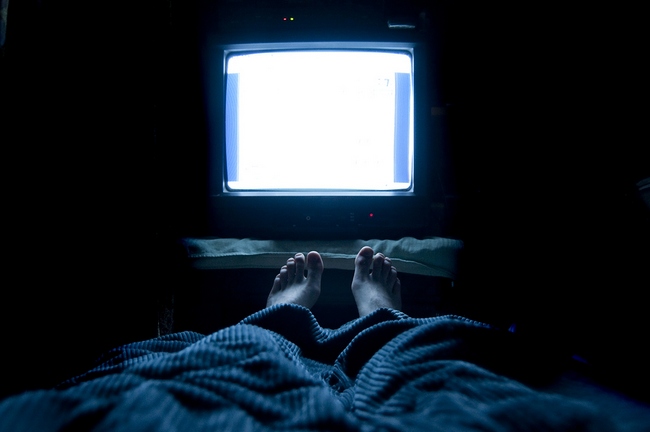- Make It Yourself Lavender Heart-Shaped Bath Bombs!
- 20 Things You Never Knew About “Down There”
- 12 Best Foods For Those Suffering From Arthritis Pain
- 12 Personal Hygiene Mistakes Almost Everyone Makes (Mom Never Told You About #4!)
- 15 Medicinal Plants And Herbs From The Cherokee People
- 12 Mind-Blowing Benefits Of Drinking Coconut Water During Pregnancy
- 12 Outstanding Winter Foods That Won’t Fatten You Up Like A Christmas Turkey
Is Your Computer or Cell Phone Slowly Killing You?

Photo credit: bigstock.com
If you are like most of us, it’s inevitable: you use a computer and/or cell phone most of the day, every day. While it’s true that modern technology has brought man a huge amount of benefits, as with everything in life, there is a give and take.
Cars are a terrific example. Your personal car can take you across the state in a matter of hours or across the country in a few days. You can carry weights across great distances that you could never carry on your own. However, you take reasonable precautions with your car. You would never (hopefully) drive your car at 100mph everywhere you go, or drive at a high rate of speed with bald tires or bad brakes, or expect to cross the Mojave desert with less than a full tank of gas. Why? Because a car can be a dangerous thing unless it is used responsibly.
Why is it then that we use our computers and cell phones we don’t take the same precautions?
The main health risks of using your computer and cell phone are:
- Exposure to electromagnetic radiation
- Heat (from laptops and tablets)
- Blue light exposure
- Sitting and poor posture concerns
Some of you probably believe that the concerns mentioned above are blown out of proportion. The truth is, however, if you do any research at all on these matters, you will see that these problems are a lot more dangerous, and much more common, than you believe. Find out also the hidden dangers f baby monitors.
Let’s take a look at the dangers and what you can do about them.
1. Exposure to electromagnetic radiation
There are several kinds of radiation that are emitted from computers and they all come with different risks.
To make this easier to understand, let’s do a short physics review.
The basic rule of energy is, the closer you are to it, the stronger the force of the energy. That’s why when you are really close to a light bulb, you can feel the heat coming off of it. If you move just a few inches away, the heat is not nearly so strong. The same applies with the radiation that your computers and cell phones give out. In physics, it’s called the inverse-square law. The intensity of the energy is proportional to 1/distance squared.
So what this means is, for example, if you are two inches away from your cell phone, you will receive only ¼ the amount of radiation exposure. When you are 4 inches away from it, you will receive only 1/8th the amount of radiation as if you were only 1 inch away. There is a reason why cell phone manufacturers tell you to keep your cell phone a few inches away from your body or your head.
There are several ways to reduce your risk of exposure. If you regularly use a laptop, especially if you use it the way the name implies, sitting on your lap, invest in one of the many pads that are designed to protect you from the radiation that these devices put out. You can also use these for your tablet as well. These mats will also help stop the heat transfer that happens with excessive laptop use.
If you talk on your cell phone quite a bit, invest in a headset. This will enable you to put your cell phone on a table, or on a chair next to you, and keep it away from your head. Don’t use a Bluetooth headset as these also emit radiation. A simple wired earpiece is all you need. You can also use the speaker option as this will also enable you to keep the phone a couple inches away from you.
SEE ALSO: WIFI, A Deadly Serious Health Risk
There have even been a few studies that show that using an earthing mat will help dispel the radiation. Putting one under your feet can help reduce your risk of overexposure as well.

Photo credit: bigstock.com
2. Limit You Exposure to Blue Light
There is mounting evidence to prove that blue light exposure after sundown interrupts your natural circadian rhythm. It’s also been shown to interfere with your body’s production of melatonin.
Why is this? Before the invention of electric lights, mankind mostly relied on sunlight as their time clock. They got up soon after sunrise and went inside soon after sunset. Their only source of light after dark was natural lights such as fireplaces, candles, and lanterns. All of these lights are orange lights. With electricity, we can now live in rooms that are filled with bright, white lights for hours after the sun has set.
It’s been shown in numerous studies that nightshift workers and night owls are at a higher risk of developing certain types of cancer, but new research shows that even just recreational exposure to blue light, even just for a few hours each evening, can have a really negative effect on our health. Some studies show that not only does this blue light disrupt our circadian rhythm, but it might be a contributing factor for heart disease, high blood pressure, obesity, and other chronic diseases.
You have two main means of avoiding the dangers of blue light. You can simply turn off these lights (computers, tablets, laptops, cell phones, and televisions) at least 2 hours before bedtime. Or you can invest in a pair of blue light blocking glasses. These look like sunglasses with orange lenses and they block the blue light that upsets our bodies. There are also free apps, such as Flux, that do the same thing. Of course, this won’t work on your television, but you could download it to your computers and cellphones.

Photo credit: bigstock.com
3. Posture and Sitting
Sitting is so much more dangerous than we know. Everyone thinks of the old “secretary spread” when it comes to sitting, but some scientists think that sitting is even more dangerous than smoking. It increases our risk of obesity, lung, breast, and prostate cancers, heart disease, diabetes, high blood pressure, and more. Research shows that sitting causes certain muscles to atrophy, and other muscles tighten up or shorten, causing things like leg, back, and shoulder pain. Extensive sitting also reduces bone density.
Poor posture while sitting and using a computer can lead to painful conditions such as computer elbow (formerly called tennis elbow) tendonitis, carpal tunnel syndrome, neck, shoulder, and back pain, just to name a few.
You can avoid most of these problems by setting a time and getting up every 30 to 60 minutes and walking for 5 minutes and/or stretching. There are also standing computer desks, which are inexpensive, and even take up less room than a regular computer desk.
Another option is to sit on a yoga ball while working. This forces your body to maintain a correct posture and works your core muscles.
As you can see, it doesn’t take much effort to greatly reduce your risk of developing computer related health problems. Your computer and cell phone should be of service to you, a compliment to your life, not a detriment. Use them wisely.

































